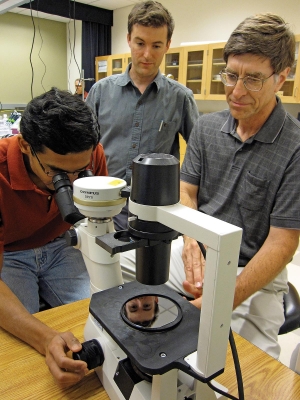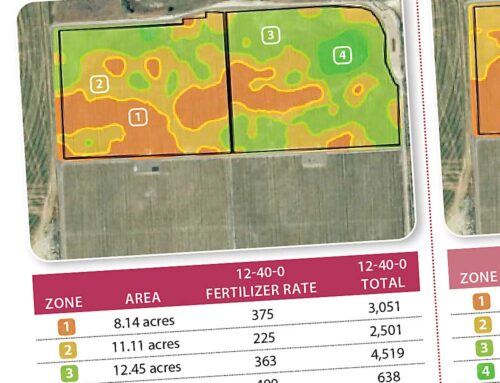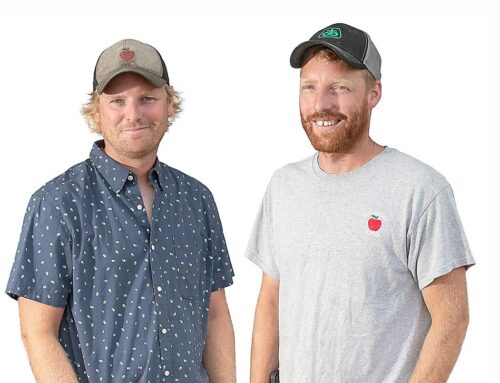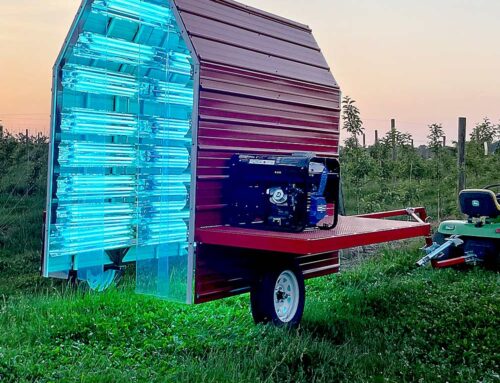
This Cornell team created the moisture-testing microsensor. From left are Vinay Pagay, Abraham Stroock, and Alan Lakso, in Cornell’s nanofabrication laboratory. Photo courtesy of Cornell University.
Cornell University researchers are developing a moisture sensor that is a miniature version of the common tensiometer but much cheaper and with at least 100 times greater range. Moreover, instead of testing soil moisture (which it can also do), it can test the actual flow of water within plants, giving a direct reading of how much moisture stress a plant is under.
It’s a dream come true for Dr. Alan Lakso, who says he’s been working to develop such a thing for more than 15 years. Now, on the eve of his retirement after 40 years at Cornell, it’s within reach. The actual device has been invented in a cooperative project with Cornell engineer Abraham Stroock and is being patented. Work still is being done to relate the readings to fruit crop growth and what actions growers should take.
Lakso says it could be a real innovation for growers of tree fruits and, especially, wine grapes. The tiny microsensors, with the size and composition of a silicon computer chip, are designed for use in soil but could also be implanted in the trunks of trees or the vines of grapes, providing a way to continually monitor the plant’s moisture needs.
Wine grape growers, many of whom have become quite sophisticated in regulatingrather than merely relievingmoisture stress on grapes, should be better able to optimize irrigation to create just the right stress level to harvest grapes of the right composition to make premium red wines.
A soil tensiometer costs about $75 or more. It contains a few ounces of water. As soil dries, it pulls water from the tensiometer through the ceramic tip, and the device measures the amount of force needed to do that, Lakso said. People have learned to translate the reading into meaningful results; it tells them how hard plants are working to extract water from the soil, how much energy they are expending to do that, and how much stress the plants are under. Then the grower can understand the effects of water stress.
The microsensor does the same thing, but it is much smallerabout one-half-inch squareand will cost much less as it is manufactured like computer chips. “Two wafers, one silicon, one glass, are bonded together with a small reservoir of water in between, and there is a tiny pressure gauge in there,” Lakso said. “While the tensiometer can measure about one bar of tension, our chip can measure at least 100 times that. We generally need to measure as much as 20 bars of tension in most crops. This has a huge range compared to current meters.”
The microsensors would be built by robots in a factory using MEMS (Micro Electrical Mechanical Systems) technology. “They are fully electronic instruments, so they can be connected by wires to a datalogger or wirelessly transmit to a computer system.” Lakso said. It’s the same kind of technology used to tell you when the tires on your car are low on air.
Lakso gives credit to two Cornell colleagues, Abraham Stroock, a professor of chemical and biomolecular engineering, and graduate student Vinay Pagay.
Pagay, who has undergraduate degrees in computer engineering and viticulture, is developing the sensor in his doctoral work. He will take a viticulture research and extension job at Oregon State University.
While the implantation of chips into trees and vines is most intriguing to Lakso, the chips can also be used to monitor soil moisture in annual plants such as corn and soybeans or vegetables. In general, annual plants are more controlled by soil moisture than are perennials.
“In trees and vines, roots are all over and at different depths so it’s not easy to predict where they are. Consequently, it’s not easy to know where to put a soil moisture tester in an orchard or vineyard,” he said. “Sometimes the roots are very deep. In annual crops, you know exactly where the roots are. In trees and vines, soil moisture is not the best measure; it’s much preferable to measure the plant directly.”
Putting the sensor right into the trees or vines will also reveal some of the dynamics of the water flow system in them. “Water stress is highly variable and dynamic,” he said. “Even a cloud passing over on a sunny day changes the stress level, so it’s important to be able to measure it often.”
The microsensor potentially has other applications as well. Researchers as well as wineries such as Ernest and Julio Gallo Winery have expressed interest in the sensors, and interest is also coming from other industries. The sensors could be used to monitor drying in processing of foods such as potato chips or oatmeal or to monitor curing of concrete in construction projects, Lakso said. •






Hello,
I have started development of an Orchard management software package, that will take a crop full circle. I was a grower during the seventies and early eighties. I am trying to get some beta testers and input.
Checkout my web site and perhaps you may know some growers who would be interested?
I want to take production, planting and returns to a new level. Track the real profitability of blocks of fruit.
Thank you for your time,
Dave DiPrete